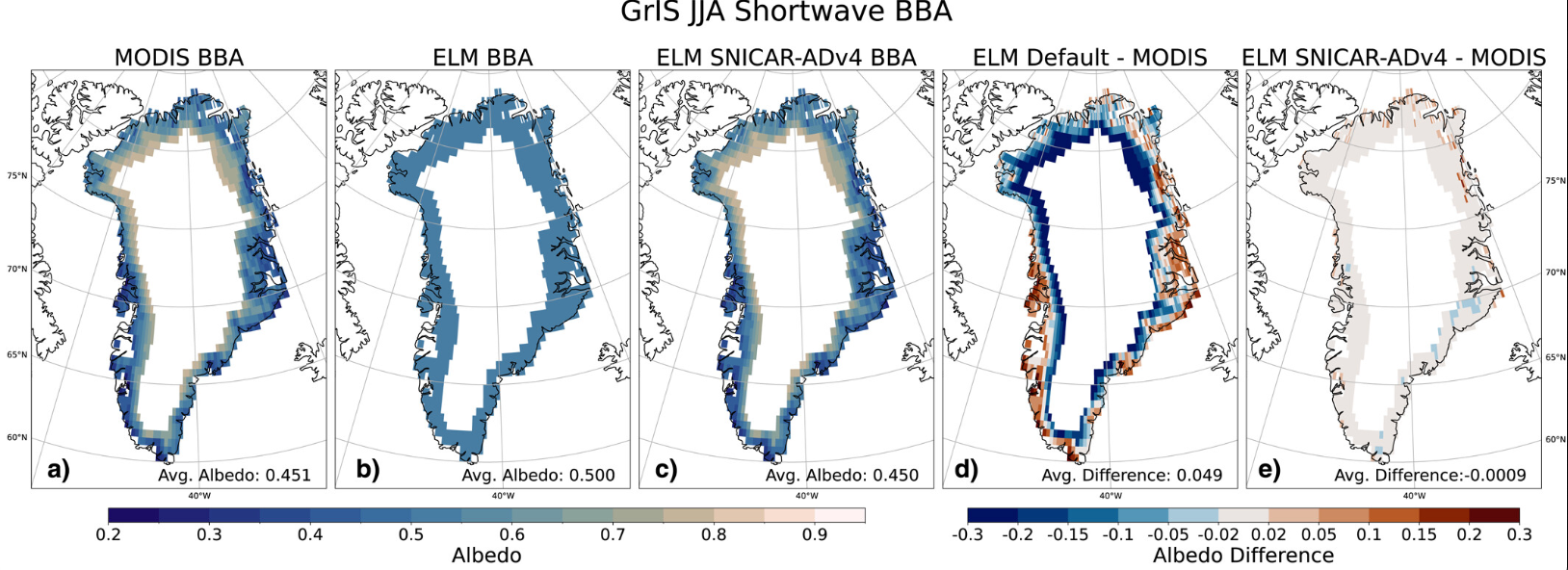The Effect of Physically Based Ice Radiative Processes on Greenland Ice Sheet Albedo and Surface Mass Balance in E3SM

Figure 1. MODIS shortwave broadband albedo (BBA) compared to the default ELM scheme and the SNICAR-ADv4 scheme over the Greenland Ice Sheet (GrIS) over Jun., Jul., Aug. (JJA). The left plot shows observed albedo, the next two show albedo computed with the two methods, and the final two plots show the differences. Notice the reduced difference for ELM SNICAR-ADv4.
The ability to quantify the Greenland Ice Sheet’s (GrIS) current and future contributions to sea-level rise is improved by a new physically based ice albedo radiative scheme in E3SM.
The Science
A new model that improves how the reflectivity, or albedo, of ice is calculated (Fig. 1) was implemented into the US Department of Energy’s Energy Exascale Earth System Model (E3SM). Simulations with the new ice reflectivity, which is informed by satellite observations, show that the old bare ice reflectivity, which was spatially and temporally constant, was too high, leading to biases in the surface mass balance and surface energy budget over the Greenland Ice Sheet (GrIS).
The Impact
Improving the representation of bare ice albedo on the GrIS to physically simulate bare ice radiative transfer processes, rather than parameterize bare ice albedo to a constant value (Fig. 2), allows for better estimations of surface melt and more realistic calculations of the surface energy budget, thus improving the ability to quantify the GrIS’s current and future contributions to sea-level rise.
Summary
The goal of this work is to improve E3SM’s treatment of ice radiative transfer modeling, specifically over the GrIS. A large portion of melt from the GrIS comes from regions with dark bare ice, however, Earth system models, such as E3SM, treat bare ice albedo as a constant. To improve the default bare ice albedo parameterization in E3SM, the researchers incorporated a physically based radiative transfer model (SNICAR‐ADv4) into the E3SM land model (ELM). They utilized satellite observations to determine spatially and temporally varying bare ice physical properties over the GrIS ablation zone to inform SNICAR-ADv4 in ELM. They assessed the impact of the new scheme on the simulated bare ice albedo and surface mass balance. The researchers found that the GrIS‐wide bare ice albedo in the old E3SMv2 scheme is overestimated by ∼4% in the visible and ∼7% in the near-infrared wavelengths compared to satellite observations. They also found that light-absorbing constituents on the ice surface, ice crustal surfaces, and melt ponds reduce visible albedo by 30% in the bare ice region of the GrIS ablation zone. Realistic ice albedo increases surface melt by ∼6 Gt/year from 2000 to 2021. The new physically realistic bare ice scheme reduces surface mass balance by ∼145 Gt, or 0.4 mm of sea‐level equivalent, between 2000 and 2021, compared to the default E3SM.
Publication
- Whicker‐Clarke, C. A., R. Antwerpen, M. G. Flanner, A. Schneider, M. Tedesco, and C. S. Zender. 2024. “The Effect Of Physically Based Ice Radiative Processes On Greenland Ice Sheet Albedo And Surface Mass Balance In E3SM”. Journal Of Geophysical Research: Atmospheres 129 (7). American Geophysical Union (AGU). doi:10.1029/2023jd040241.
Funding
- This work was supported by the Earth System Model Development program area of the Department of Energy, Office of Science, Biological and Environmental Research program.
Contact
- Chloe Whicker-Clarke, Department of Climate and Space Sciences and Engineering University of Michigan Ann Arbor MI USA, Department of Earth System Science University of California Irvine CA USA
This article is a part of the E3SM “Floating Points” Newsletter, to read the full Newsletter check:



